#1883 icons
Explore tagged Tumblr posts
Text













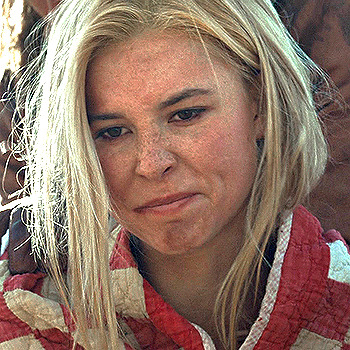




Isabel May as Elsa Dutton 1883 (2021-2022), Season 1
#icons#1883 icons#elsa dutton icons#isabel may icons#tv series icons#tv shows icons#tv icons#tvedit#period drama icons#drama icons#tv shows#tv#1883edit#1883#isabel may#elsa dutton#fancaps
146 notes
·
View notes
Text



please like if you use.
6 notes
·
View notes
Text









icons of Harriet Slater by David Reiss Photography
#harriet slater icons#harrietslateredit#harriet slater#outlandercastedit#underused fc#1883 magazine#rp icons#icons#*icons#*mine
5 notes
·
View notes
Text

140 ICONS OF GRATIELA BRANCUSI IN 1883
all icons are free to use with credit to @argentangelhelps !
you may edit to your liking (add borders, psds, textures ect)
do not use for : celebrity/real person rps or paid commissions, everything else is up to user discretion. (don’t make me change this rule)
they are edited (sharpened) in ps, however they are meant to be used under the psd of your choice! if you choose to use them as they are they should work just fine! they are 100px & 75px square and do not come with any borders.
all screencaps used are my own, and they are available for download HERE!
FACECLAIM INFO : gratiela is romanian romani & greek
TRIGGER WARNINGS : n/a
the zip file is free to download on my PAYHIP!
LIKE OR REBLOG IF YOU SAVE OR USE!
#gratiela brancusi#gratiela brancusi base icons#gratiela brancusi rp icons#1883 cast#periodfcnetwork#rp icons#base icons#free rp icons#free base icons#*[ rp icons ]#*[ period resources ]
4 notes
·
View notes
Text




EDVARD MUNCH - THE SCREAM, 1893
Originally named "The Scream of Nature," the painting shows a figure resembling a skeleton, standing on a bridge with hands covering his face, screaming. Two individuals observe from afar. The simplified shapes, color palette, and perspective are all characteristic of Munch's unique style.
Munch wrote in his diary his inspiration for this piece. It reads, “I was walking down the road with two friends when the sun set; suddenly, the sky turned as red as blood. I stopped and leaned against the fence, feeling unspeakably tired. Tongues of fire and blood stretched over the bluish black fjord. My friends went on walking while I lagged behind, shivering with fear. Then I heard the enormous, infinite scream of nature.”
What Munch witnessed could possibly be attributed to the explosion of a volcano on the island of Krakatoa in May 1883, located in present-day Indonesia. The massive explosion had a global impact. Munch and his friends likely witnessed the amazing red sunsets due to gases being dispersed into the atmosphere. Similar effects were reported as far as the United States, quite far from its origination.
This work speaks to individuals and is interpreted as a representation of the universal anguish of modern humans. Today, it is considered an iconic symbol. It is acknowledged not only by art enthusiasts but also by the general public. In 1994, this particular edition of “The Scream” was stolen from the National Gallery in Oslo, Norway. Luckily, it was found shortly thereafter.
49 notes
·
View notes
Note
Who are your favorite artists? The art kind.
I'm a bit surprised I haven't been asked this question before!
I appreciate so many artists that it's hard to narrow it down. But based on what I can remember and what I can check on my Instagram and bookshelf, here are some of my favorites:

Gustave Doré (1832–1883) → A French artist, illustrator, and sculptor, celebrated for his intricate and dramatic engravings and illustrations. He is best known for his illustrations of classic literary works, including Dante Alighieri's The Divine Comedy, John Milton's Paradise Lost, and Edgar Allan Poe's The Raven. His skillful blend of realism and romanticism, combined with his mastery of visual storytelling, has established him as a significant figure in the history of illustration and fine art.

Vincent van Gogh (1853–1890) → A Dutch post-impressionist painter renowned for his expressive use of color and bold brushwork, which had a profound influence on 20th-century art. His most famous works, such as Starry Night, Sunflowers, and The Bedroom, showcase his unique style and emotional depth, capturing the beauty of the world around him.

Henriëtte Ronner-Knip (1821–1909) → A Dutch-Belgian painter best known for her detailed and charming depictions of domestic cats. Specializing in animal paintings, her style combined realism and a romantic touch, often portraying cats in cozy, playful, or elegant settings that captured their personalities and grace. She was celebrated for her ability to convey texture, particularly in fur, and created intimate, lifelike scenes that became popular in 19th-century bourgeois society.

John William Waterhouse (1849–1917) → A British painter associated with the Pre-Raphaelite movement, known for his romantic and mythological subjects. His art style blends elements of Romanticism and Classicism, featuring realistic figures, rich colors, and a strong focus on nature and detail. Waterhouse is best known for his depictions of female figures from mythology and literature, such as The Lady of Shalott and Ophelia, which convey a sense of beauty, melancholy, and mystery, making his work iconic in the realm of 19th-century art.

Harry Clarke (1889–1931) → An Irish stained-glass artist and illustrator. His work was influenced by Gothic art, Symbolism, Art Nouveau, and Irish folklore. This blend resulted in a distinctive aesthetic that harmoniously intertwines beauty with darker themes. Clarke is best known for his illustrations in classic literary texts, including James Joyce's Dubliners and Edgar Allan Poe's Tales of Mystery and Imagination. In these works, his illustrations masterfully balance whimsy and darkness, creating striking visual narratives that continue to resonate with audiences.

Alphonse Mucha (1860–1939) → A Czech painter and decorative artist best known for his distinctive Art Nouveau style, characterized by intricate, flowing lines, elaborate floral motifs, and a harmonious use of soft colors. Mucha's work often features idealized female figures, embodying beauty and elegance, and is heavily inspired by his fascination with nature and Slavic folklore. He gained fame for his poster designs, particularly those promoting the actress Sarah Bernhardt, as well as his decorative panels and illustrations.

J.C. Leyendecker (1874–1951) → An American illustrator renowned for his iconic magazine covers and advertising art, particularly his work for The Saturday Evening Post and the Arrow Collar Man campaign. Leyendecker's mastery of visual storytelling and branding helped shape American commercial art in the early 20th century, and he significantly influenced later artists, including Norman Rockwell.

Leonid Afremov (1955–2019) → A Belarusian-born artist known for his vibrant, impressionistic paintings created using a palette knife technique. His distinctive art style features bold colors and dynamic brushstrokes, often depicting landscapes, city scenes, and emotional moments, such as rain-soaked streets or sunlit parks.

Ayami Kojima → A Japanese artist and illustrator best known for her work in video game design, particularly as the character designer for the Castlevania series. Her art style is characterized by intricate, gothic aesthetics, combining dark fantasy elements with a detailed, ethereal quality.

Victoria Francés → A Spanish illustrator known for her evocative illustrations that blend gothic, fantasy, and romantic themes. She is particularly known for her illustrated books, including the popular series Faery Tales, which showcases her unique blend of fantasy and gothic aesthetics.

Yoshitaka Amano → A Japanese artist and illustrator renowned for his distinctive style in character design and concept art, particularly for the Final Fantasy video game series. His style fuses his interests in traditional Japanese aesthetics like those of wood block prints with Western fantasy elements. It results in ethereal forms, and a dreamlike quality, especially with Amano's use of watercolor techniques and intricate details to create a sense of movement and fluidity in his work.

Nico Delort (IG: nicodelort) → A French illustrator known for his detailed, black-and-white artworks created using scratchboard techniques. His art style is heavily influenced by the aesthetics of 19th-century engravings and woodcuts, blending elements of Gothic, fantasy, and mythological themes. Delort's work is recognized for its dramatic use of light and shadow, intricate textures, and atmospheric depth, often depicting moody, fantastical scenes.

Vania Zouravliov → A Russian-born artist known for his intricate, surreal illustrations that blend dark, fairy-tale-like themes with fine detail and symbolism. Zouravliov's work explores beauty and darkness, merging the macabre with the fantastical.

James Jean (IG: jamesjeanart) → A Taiwanese-American visual artist and illustrator known for his surreal, highly detailed works that blend elements of fantasy, mythology, and pop culture. Jean gained early recognition for his award-winning covers for DC Comics' Fables series.

Audrey Kawasaki (IG: audkawa) → A Japanese-American artist known for her blend of contemporary Japanese aesthetics and Western art influences. Her ethereal paintings often depict young women surrounded by nature, featuring intricate line work and a soft color palette. Her works are typically painted on wood panels, adding a quality that enhances the emotional depth of her subjects.

Jessica Cioffi (IG: Loputyn) → An Italian artist known for her enchanting illustrations and concept art that seamlessly blend traditional and digital techniques. Her work reflects the influence of 19th century neo-gothic and Japanese manga, and among the artist's favorite themes are witchcraft, folklore, and mystery.

Gretel Lusky (IG: gretlusky) → An Argentine digital artist and illustrator, Gretel Lusky is recognized for her whimsical, vibrant artwork featuring fantasy characters, and magical themes. Her style blends cartoon and anime elements, characterized by bold lines, expressive characters, and a colorful palette. She is well-known for her enchanting illustrations on social media, where she shares art tutorials and collaborates on various comics, book covers, and other projects. She is also known for her debut graphic novel Primer, an original graphic novel for DC Comics.

Margaret Morales (IG: margaretmoralesart) → A Filipino watercolor artist currently residing in America. Margaret Morales is known for her dreamy, ethereal portraits that intertwine feminine figures with elements of nature, such as flowers and animals. Her style, characterized by soft brushwork and pastel hues, creates a surreal, fairytale-like atmosphere. Her evolving work draws inspiration from art nouveau, mythology, fantasy, natural elements, Japanese/manga art, and fashion.

Tactooncat → An Indonesian digital artist known for creating illustrations that feature cats in a humorous and whimsical style, particularly cat memes and videos. Their work appeals to cat lovers and fans of lighthearted, expressive illustrations.
There are so many more, but hopefully the ones I've mentioned have caught your interest enough that you'll want to look them up. Each artist offers a unique perspective, whether through their distinctive style, use of color, themes, or techniques—there’s plenty to discover and enjoy.
#ask#anon ask#artists#art#artwork#anonymous#gustave dore#vincent van gogh#henriette ronner-knip#john william waterhouse#harry clarke#alphonse mucha#j.c. leyendecker#leonid afremov#ayami kojima#victoria frances#yoshitaka amano#nico delort#vania zouravliov#james jean#audrey kawasaki#jessica cioffi#loputyn#gretel lusky#margaret morales#tactooncat
38 notes
·
View notes
Text

Ivan the Terrible and His Son Ivan by Ilya Repin
Oil on canvas , 1883-1885
is a famous and controversial painting. It depicts the historical event of Ivan the Terrible, the Grand Prince of Moscow, accidentally killing his eldest son, Tsarevich Ivan Ivanovich, in a fit of rage in 1581.
Repin's painting captures the intense emotions of the moment, with Ivan's face contorted in horror and grief, and his son's body limp in his arms. The painting portrays the anguish and remorse on the face of the elder Ivan and the shock and heartbreak of the dying Tsarevich, shedding a tear at the unexpected betrayal and shock of having been killed by his father's hands. The painting has been interpreted in various ways, with some seeing it as a condemnation of tyranny and others as a portrayal of a tragic human moment.
The painting has been the subject of controversy and vandalism over the years, reflecting its powerful and disturbing depiction of a historical event. It remains one of the most iconic and debated works in Russian art.
16 notes
·
View notes
Text

Figaro's Famous Fanfare | 66 Brilliant Baritones Battle OUT NOW!
Gioachino Rossini’s opera Il Barbiere di Siviglia (The Barber of Seville) remains one of the most beloved and enduring works in the operatic repertoire.
Among its many memorable moments, Figaro's entrance aria, "Largo al Factotum," stands out as a tour de force for the baritone voice and a cornerstone for both character development and comedic expression.
The famous "Figaro, Figaro, Figaro" section, performed unaccompanied, exemplifies Rossini's wit, musical humour, and masterful control of operatic timing.
This moment showcases the singer’s vocal precision, agility, and musicianship, while also highlighting their acting skills, characterisation, dramatic flair, and ability to engage the audience.
In this 10-minute video, 66 great operatic baritones bring their own unique interpretations to this iconic a cappella passage.
List of Figaros:
Giuseppe Campanari [1855–1927] — Over 200 Met performances Mattia Battistini [1856–1928] — ‘King of Baritones’ Joseph Winogradoff [1866–1936] — Sang Figaro in Yiddish John Forsell [1868–1941] — Debuted as Figaro Mario Sammarco [1868–1930] — Noted for versatility & acting Emilio De Gogorza [1872–1949] — Recorded prodigiously
Riccardo Stracciari [1875–1955] — Figaro a signature role Giuseppe De Luca [1876–1950] — Created Sharpless & Schicchi Titta Ruffo [1877–1953] — ‘Voice of The Lion’ Pasquale Amato [1878–1942] — Sang at the Met 1908–1921 Peter Dawson* [1882–1961] — Bass-baritone. Over 1500 recordings Carlo Galeffi [1882–1961] — One of the finest interwar baritones
Enrico Molinari [1882–1956] — Sang as bass & baritone Armand Crabbé [1883–1947] — A lead in London 1906–1914, 1937 Giuseppe Danise [1883–1963] — Four Met premieres Anafesto Rossi [1883–1933] — Graduated as a bass Enrico De Franceschi [1885–1945] — Figaro in Turin & Honduras Umberto Urbano [1885–1969] — Recorded ‘marvels of lyric beauty’
Apollo Granforte [1886–1975] — c.1800 performances Giulio Fregosi [1887–1951] — Figaro in Paris Luigi Montesanto [1887–1954] — Created Michele Giacomo Rimini [1887–1952] — Sang Figaro with GalliCurci Heinrich Schlusnus [1888–1952] —Top German interwar lyric baritone Mariano Stabile [1888–1968] — Outstanding singing-actor
Richard Bonelli [1889–1980] — Sang Figaro in early sound film Benvenuto Franci [1891–1985] — A top Figaro interpretator John Charles Thomas [1891–1960] — Hollywood Walk of Fame Mario Basiola [1892–1965] — 66 roles. Taught by Cotogni Giovanni Inghilleri [1894–1959] — Sang with Ponselle & Gigli Lawrence Tibbett [1896–1960] — Legendary singer & actor
Iso Golland [1898–1961] — Respected pedagogue Dennis Noble* [1898–1966] — Bristolian [UK]. Prolific broadcaster Carlo Tagliabue [1898–1978] — Sang Wagner, Excelled at Verdi Ivan Petroff [1899–1963] — Debuted as Figaro Igor Gorin [1904–1982] — Cantor fluent in 8 languages Alexander Sved [1906–1979] — Taught by Sammarco & Stracciari
Frank Valentino [1907–1991] — 26 roles in 21 seasons at the Met Leonard Warren [1911–1960] — Met lead. Had a top C Gino Bechi [1913–1993] — Cast in musical films Tito Gobbi [1913–1984] — 136 roles over 44 years Paolo Silveri [1913–2001] — Sang as bass, baritone & tenor Giuseppe Valdengo [1914–2007] — Debuted as Figaro
Josef Metternich [1915–2005] — Created Hindemith’s Kepler Giuseppe Taddei [1916–2010] — Aged 69 at Met debut Robert Merrill [1917–2004] — Met’s principal baritone Manuel Ausensi [1919–2005] — Famous full recording of this opera Sesto Bruscantini [1919–2003] — Also sang Bartolo Aldo Protti [1920–1995] — Student of Basiola
Ettore Bastianini [1922–1967] — Recorded this opera for Decca Cornell MacNeil [1922–2011] — ‘Rivals, but [..] no equals’ Renato Capecchi [1923–1998] — Singer, actor & director Frank Guarrera [1923–2007] — Figaro a signature role Rolando Panerai [1924–2019] — More than 150 roles. Famed for buffo Piero Cappuccilli [1926–2005] — 17 major Verdi roles
Nicolae Herlea [1927–2014] — Sang Figaro c.550 times Peter Glossop [1928–2008] — A lead in London, Europe & USA Hermann Prey [1929–1998] — Figaro in film and live TV Yuri Gulyayev [1930–1986] — Figaro a best role Yuri Mazurok [1931–2006] — People’s Artist of the USSR Stoyan Popov [1933–2017] — ’The Bulgarian Titto Gobbi’
Sherrill Milnes [1935-] — Recorded Figaro under Levine Franco Pagliazzi [1937–2018] — Became dramatic tenor Silvano Carroli [1939–2020] — Taught by Mario Del Monaco Muslim Magomayev [1942–2008] — ’Soviet Sinatra’ Allan Monk [1942-] — Awarded a Golden Jubilee Medal Amartuvshin Enkhbat [1986-] — Numerous international awards
*Recorded 'Largo al Factotum' in the Key of Bb

Please join me for the premiere of this new video and share your thoughts in the comments and in the chat! I’m curious… Who’s YOUR favourite Figaro?! 🎶
There's a 'notify me' option available on the video page
Feel free to invite anyone else who might enjoy it— I look forward to you joining me there! Moodoo Van Spoon
youtube
11 notes
·
View notes
Text









Fillide Giorgi Levasti (Florence, 1883 – Florence, 1966)
Fillide Giorgi Levasti was an italian painter, pupil of one of the major painter of the italian 19th century, Giovanni Fattori, and longtime friend of other women artists like Leonetta Cecchi Pieraccini (mother of Suso Cecchi d'Amico, the future screenwriter of many iconic italian movies) and Evelyn Scarampi. She was a great admired of Paul Cézanne, and the post impressionism and symbolist artists from Central Europe.
#women artist#female artist#women art#female art#italian art#post impressionism#roman school#italian artist#italian women#italian history#florence#herstory#Fillide Giorgi Levasti#macchiaioli#20th century art#modern art
7 notes
·
View notes
Text





















Isabel May as Elsa Dutton 1883 (2021-2022), Season 1
#icons#1883 icons#elsa dutton icons#isabel may icons#tv series icons#tv shows icons#tv icons#tvedit#period drama icons#drama icons#tv shows#tv#1883edit#1883#isabel may#elsa dutton#fancaps
58 notes
·
View notes
Text

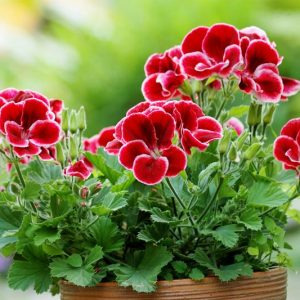
The Annotated Anne of Green Gables ~~ a special rereading
CHAPTER IV ~~ Morning at Green Gables
hello everyone, i am back! i have actually been traveling this past month abroad and have not really had much ability to be on tumblr, but i have returned so expect more from me again!
"I think he's lovely...He is so very sympathetic. He didn't mind how much I talked -- he seemed to like it. I felt that he was a kindred spirit as soon as I ever saw him."
Anne's iconic recurring title of 'kindred spirit' for people she connects with on a deep level probably comes from a well-known poem by Thomas Gray, a very popular English poet, despite only publishing thirteen poems in his lifetime. The poem "Elegy in a Country Churchyard" was found in the Fifth Royal Reader, published in 1873, so it is likely Anne would have come across this term there, but this term is also located in The Story of an African Farm by Olive Schreiner, published in 1883, and Elizabeth Von Arnim's Elizabeth and Her German Garden, published in 1898. While it is not completely certain where L.M. Montgomery would have first heard this term, odds point to the Gray poem, and based on the timeline of Anne, it appears this would also be where Anne Shirley would have picked it up. That part of the poem goes as follows: "for thee, who mindful of the unhonored dead / Dost in these lines their artless tale relate, / If chance, by lonely contemplation led, / Some kindred spirits shall inquire thy fate," (Stanza 24, 11. 93-96). Gray's poem was partly inspired by the death of fellow poet Richard West and its themes include death and remembrance. This is an interesting place for Anne to pick up from, noting that she herself has experienced loss, most intimately in that of her parents. I wonder if she thinks of herself as her parents' kindred spirit who thinks about them after they passed, and she herself longs for someone who will remember her so deeply even when she has gone somewhere else.
"Oh, I like things to have handles even if they are only geraniums. It makes them seem more like people. How do you know but that it hurts a geranium's feelings just to be called a geranium and nothing else? You wouldn't like to be called nothing but a woman all the time. Yes, I shall call it Bonny. I named that cherry-tree outside my bedroom window this morning. I called it Snow Queen because it was so white."
This passage makes it abundantly clear that L.M. Montgomery inspired Anne from her own childhood experiences. This instance is taken almost exactly from her journal. On September 21, 1889, when she was thirteen years old, she wrote: "There wasn't any school, so I amused myself repotting all my geraniums. Dear things, how I love them! The 'mother' of them all is a matronly old geranium called 'Bonny.' I got Bonny ages ago -- it must be as much as two or three years ... I called it Bonny -- I like things to have handles even if they are only geraniums ... And it blooms as if it meant it. I believe that old geranium has a soul!" It seems that L.M. Montgomery went through her earlier journals and looked for examples of youthfulness that she could use to create Anne!
next chapter
#anne of green gables#aogg#anne shirley#anne with an e#awae#lm montgomery#thomas gray#kindred spirits#geraniums
19 notes
·
View notes
Text
I've recently done a little bit of research for some stuff adjacent to the production of The Adventures of Sherlock Holmes that I'm in right now and, in checking whether certain scientific institutions and inventions would have existed during the time of the play, I discovered something kind of interesting: many of the ones I've looked up were coincidentally established within 5-10 years of the setting.
The first bunch of Sherlock Holmes stories, the source materials for this play, came out between 1887 and 1893. The Natural History Museum? Opened fully in 1883. The Prime Meridian? Officially established in 1884. Tower Bridge? Built between 1886-1894. The Tube running northwest from Baker Street? 1880. London's first electrical power station? 1882. Those are just the ones I happened to look up. Telegrams are common in the Sherlock Holmes tales, and by the later Sherlock Holmes stories, he's using a telephone and even automobiles are mentioned.
Reading the Sherlock Holmes stories with that context of a world full of rapid changes and advancements, I feel like it comes across differently. It seems to say, "There's a scientific answer for everything." His unique detecting style, based on simple observations, made it seem like the age-old problems of crime and criminals could be defeated by logic and reasoning. I think there's a level of idealism, that even the most difficult crimes are solvable and bad actors are no match for modern scientific knowledge.
Reading Sherlock Holmes cases often gives the comfortable feeling of order and justice being served. I think that's the same reason true crime content is so popular today in another age of rapid digital advances-- and if we guess the solution, it's doubly satisfying. It's also why Sherlock Holmes is so easily translated to modern day.
But that also makes me think about another book and another equally iconic character that came out around that same time period: Dracula, published in 1897. And Dracula takes a lot of the same themes and seems to say the exact opposite.
I think one of the biggest things that surprises first-time readers of Dracula is how modern Dracula feels and how much technology is used in the book. Like the Sherlock Holmes stories, it was set in roughly 'modern day' when it was written. The 'good guys' use trains, telephones, typewriters, and even blood transfusions. But when Dracula, an old-world monster, arrives in their modern newfangled city of London, all of that technology is useless against him. And so is any ability of theirs to deduce a simple scientific explanation for what's going on.
When Dracula starts sneaking into their friend’s house and sucking her blood each night, the signs are obvious, right down to the puncture marks on her neck. The reader and audience knows what’s up waaaay before the characters do. It’s infuriating! You want to jump up and down and yell, “A VAMPIRE IS KILLING HER!” But why don’t they see what’s right in front of their faces? Because they’re thoroughly modern upper-middle class British people who live in a scientifically advanced world and believe in reason.
The chaos of true evil is more powerful than logic and reason. To defeat him, they need to get on his level and use superstition and religion and folklore. It's the polar opposite of a story like "The Hounds of the Baskervilles," published five years later.
All that said... I would love to see a Sherlock Holmes and Dracula crossover. How long would it take Holmes to deduce that he had run into a real vampire? Would he make all the correct observations and keep coming to the wrong conclusions? Would he be able to accurately predict the patterns of Dracula's behavior when his opponent has superhuman abilities and can transform into multiple different types of animals?
Or, given Holmes' somewhat addictive and adrenaline-driven personality, his superior attunement to his senses, his surprising revival from the dead, and his innate instinct to 'catch his man' at any cost... would he himself make the most dangerous vampire of all?
36 notes
·
View notes
Text

607 ICONS OF ISABEL MAY IN 1883
all icons are free to use with credit to @argentangelhelps !
you may edit to your liking (add borders, psds, textures ect)
do not use for : celebrity/real person rps or paid commissions, everything else is up to user discretion. (don’t make me change this rule)
they are edited (sharpened) in ps, however they are meant to be used under the psd of your choice! if you choose to use them as they are they should work just fine! they are 100px & 75px square and do not come with any borders.
all screencaps used are my own, and they are available for download HERE!
FACECLAIM INFO : isabel is white
TRIGGER WARNINGS : kissing/implied intimacy, blood
the zip file is free to download on my PAYHIP!
LIKE OR REBLOG IF YOU SAVE OR USE!
#isabel may#isabel may rp icons#isabel may base icons#elsa dutton#1883 series#periodfcnetwork#rp icons#base icons#free rp icons#free base icons#*[ rp icons ]#*[ period resources ]
3 notes
·
View notes
Text

SORROW FOUND ME. independent and private multi muse with extremely low activity and way too many muses loved and sometimes ignored by lacy.

❝ sorrow found me when i was young. sorrow waited. SORROW WON. ❞

rules and muses found under the cut
01. my name is lacy and i’m 25+ years old. i’m an aries with my moon in sagittarius, cancer ascendant and i have no idea what any of this means. i'm not affiliated with anything.
02. the psd i’m currently using was made by pinkinnards and icon border was made by me, but i’ll also use various psds from various creators. all credit really goes to them and none to me. i’ll probably use psd’s by venuscommissions, plutocommissions, calisources and more. if you ever have any questions, please feel free to shoot me a message. i promise, i don’t bite.
03. i will probably practice exclusivity and mains and affiliates, but at the moment i don't have any.
04. i ask that you please not follow me and then unfollow me to follow me again and try to get me to follow you. that will not make me follow you, it’ll just make me softblock you and then hardblock if it continues. also, please don’t like my starter calls or send me meme’s if we’re not mutuals. i am mutuals only.
05. i don’t usually write smut, but if i'm really comfortable with another person then i don't mind giving it a try. i do ask that you please tag your smut though and don't try to force me to write it.
06. i will not follow people that use certain faceclaim’s. gal gadot, chris pratt, ezra miller, scarlett johansson and more probably. if you have questions about why then just send me an ask and i’ll let you know. i’m uncomfortable with them and i just want to be comfortable on my blog.
07. i am extremely slow and i honestly can't help that. i have a full time job and at the moment am only getting one day off a week. it's exhausting, but i'm doing my best.
KDRAMAS: naksu/cho-yeong - alchemy of souls - go yoonjung ahn min-hyuck - strong woman do bong-soon - park hyungsik kim shin - goblin - gong yoo cha sunghoon - business proposal - kim minkyu shin hari - business proposal - kim sejeong ryu sunjae - the lovely runner - byeon wooseok bae rona - penthouse: war in life - kim hyunsoo oh injoo - little women - kim goeun na wondeuk/lee yul - 100 days my prince - do kyungsoo lim jugyeong - true beauty - moon gayoung lee suho - true beauty - cha eunwoo han seojun - true beauty - hwang inyeop
TELEVISION: nancy wheeler - stranger things - natalia dyer sarah cameron - outer banks - madelyn cline nancy drew - nancy drew - kennedy mcmann clarke griffin - the 100 - madelyn cline elena gilbert - the vampire diaries - nina dobrev josette 'josie' saltzman - the legacies - kaylee kaneshiro willow rosenberg - buffy the vampire slayer - alyson hannigan kara danvers/zor-el - supergirl - melissa benoist mia smoak-queen - arrow - brec bassinger louis de pointe du lac - interview with a vampire - jacob anderson lesta de lioncourt - interview with a vampire - sam reid daisy jones - daisy jones & the six - riley keough elsa dutton - yellowstone: 1883 - isabel may
ANIMATED: vi - arcane jinx - arcane mel - arcane vex'ahlia vessar - lovm/critical role keyleth - lovm/critical role
VIDEO GAMES: jessica riley - until dawn - tbd mia winters - resident evil rosemary winters - resident evil daniela dimitrescu - resident evil
LITERATURE: nesta archeron - acotar - tbd elide lochan - throne of glass - emily bader manon blackbeak - throne of glass - tbd ariadne - crescent city - tbd sathia flynn - crescent city - tbd danika fendyr - crescent city - tbd isabel 'belly' conklin - the summer i turned pretty - jung chaeyeon elizabeth bennet - pride and prejudice - keira knightley sophie baek - bridgerton - tbd hyacinth bridgerton - bridgerton - tbd
5 notes
·
View notes
Text
Images of Geneviève Lantelme -
According to Wikipedia "Geneviève Lantelme (born Mathilde Hortense Claire Fossey, 20 May 1883[1] – 24/25 July 1911) was a French stage actress, socialite, fashion icon, and courtesan. Considered by her contemporaries to be one of the most beautiful women of the Belle Epoque and bearing a resemblance to American actress Ethel Barrymore, she is remembered for the mysterious circumstances of her death: on the night of 24/25 July 1911, she fell from the yacht of her husband, Alfred Edwards."
1902 (May issue) Lantelme in Paquin, Les Modes May issue. From verbinina.wordpress.com/page/8/ 2106X3000.

1902 Geneviève Lantelme, Théâtre du Gymnase, photo by Reutlinger, Les Modes July 1902. From les-modes.tumblr.com/image/51225719455; fixed spots w Pshop 1280X1779.

Genevieve Lantelme in Doucet by Reutlinger. From tumblr.com/beautifulcentury859X1600.

ca. 1905 Geneviève Lantelme by Henri Manuel. From Wikimedia 2283X2883.
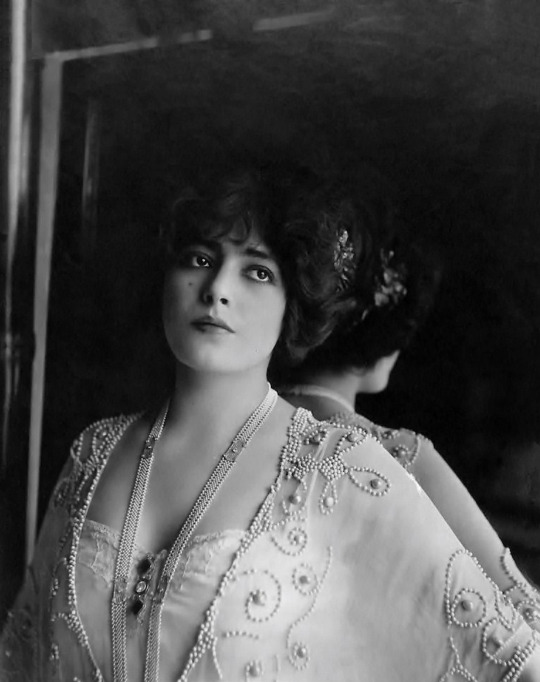
1907 Mademoiselle Lantelme by Giovanni Boldini (Galleria Nazionale d'Arte Moderna e Contemporanea - Roma, Italy). From Wikimedia 1474X2776.

1907 April Mlle. Lantelme of the Theatre Rejane with lace-trimmed celadon day dress, with pink roses and feathers in her red hair, wearing rings of white and black pearls, photographed by Paul Boyer, on cover of French periodical les Modes 853X1280.
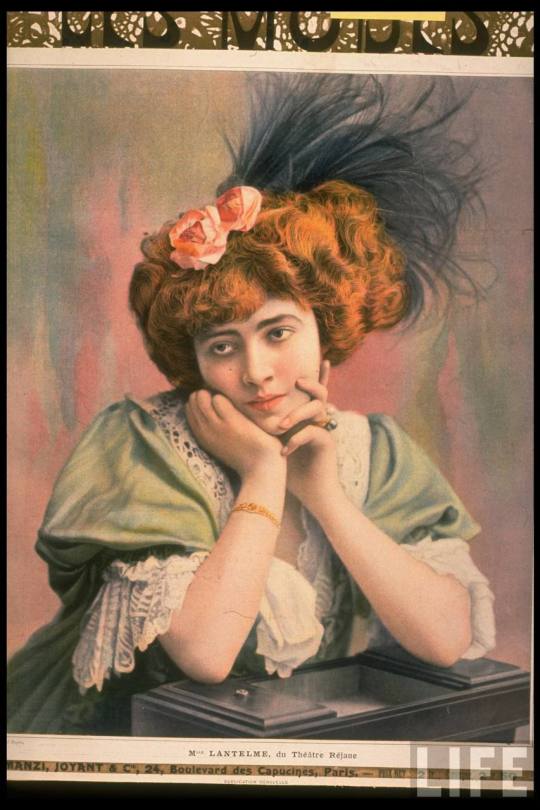
Lantelme in Paquin day dress by Félix. From verbinina.wordpress.com/page/6/ 1266X2806.

ca. 1908/1909 Lantelme in Vionnet gown by ?. From verbinina.wordpress.com/page/3/; fixed larger spots w Pshop 1280X1707.

1910 (June) Genviève Lantelme in Maison Drion-Régnier sheath evening dress, Les Modes - photo by Félix. From les-modes.tumblr.com/page/28 1280X1784.

1910 Geneviève Lantelme in Le Costaud des Epinettes by Abel Faivre (location ?). From Wikimedia 1190X1620.

Lantelme in Paquin afternoon dress by Félix. From verbinina.wordpress.com/page/6/ 1789X2395.
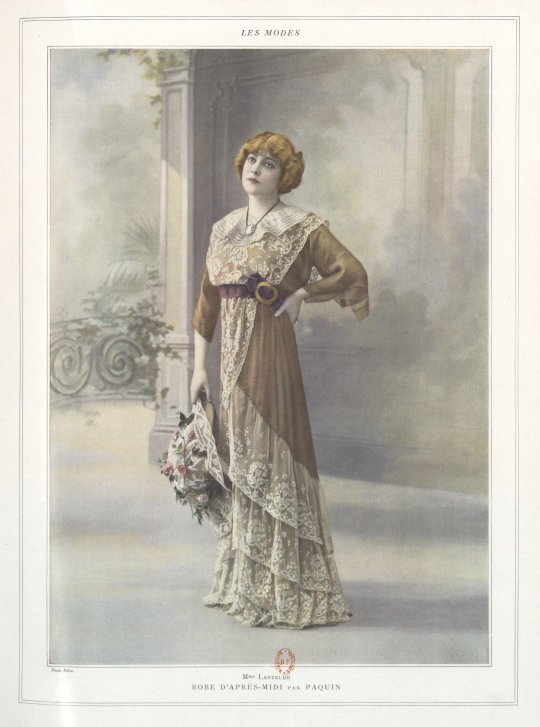
1910 Lantelme in Paquin photo Reutlinger. From verbinina.wordpress.com/page/6/ 2048X3060.
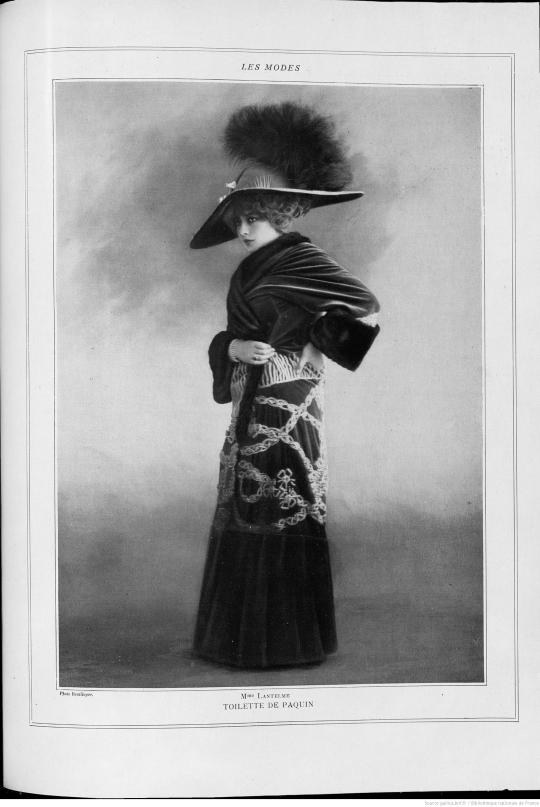
1911 Elegante et son chien (Lantelme with blue hortensias) by Antoon van Welie (location ?). From verbinina.wordpress.com/2015/03/06/an-unknown-portrait-of-lantelme/; doubled size 1600X1032.
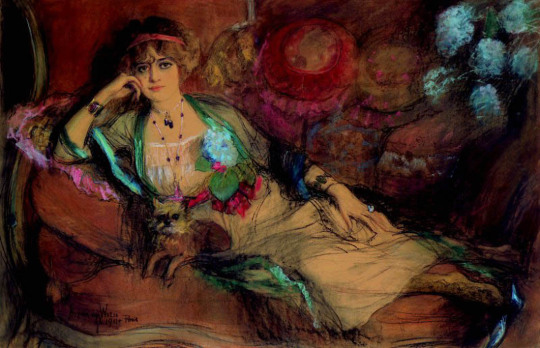
1911 Lantelme photo in 2 August 1911 issue of The Bystander. From verbinina.wordpress.com/page/2/; fixed spots w Pshop 815X1186.
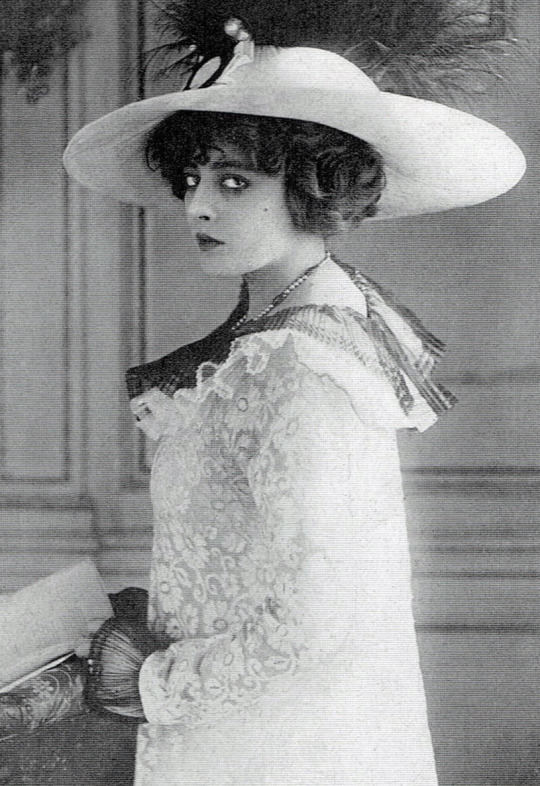
1911 Un Vendredi au Salon des Artistes français by Jules-Alexandre Grün (Musée des Beaux-Arts de Rouen - Rouen, Normandie, France). From verbinina.wordpress.com/page/7/; fixed spots & abrasion flaws w Pshop 4800X2800. Lantelme is at the visual center of this work.

Lantelme and dogs by Reutlinger. From verbinina.files.wordpress.com/2015/06/lantelme-cabinet-photo-with-2-dogs; adjusted borders & fixed flaws w Pshop 1094X1594.

Lantelme in La Gamime wearing Paquin by Reutlinger. From verbinina.wordpress.com/page/6/ 1230X1636.

Lantelme in Paquin by Manue. From verbinina.wordpress.com/page/6/ 2197X3360.

Lantelme in Paquin. From verbinina.wordpress.com/page/6/ 1401X2000.

#Belle Époque fashion#1900s fashion#1910s fashion#Paquin#Jeanne Paquin#Jacques Doucet#Drion-Régnier#Madeleine Vionnet#Reutlinger#Félix#Giovanni Boldini#Abel Faivre#Manue#Antoon van Welie#Jules-Alexandre Grün
35 notes
·
View notes
